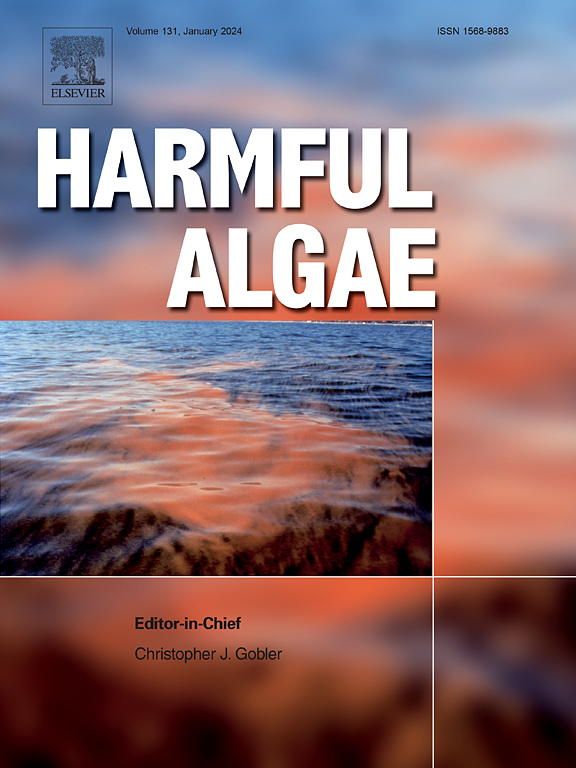Deciphering the response mechanism of microorganisms to green tide outbreaks: Diversity, assembly processes, and co-occurrence patterns
IF 4.5
1区 生物学
Q1 MARINE & FRESHWATER BIOLOGY
引用次数: 0
Abstract
Green tide, a widespread coastal water environmental issue, significantly impacts the ecology of nearshore microorganisms. Despite extensive research on green tides, the dynamics of microbial communities and their assembly mechanisms throughout the development of these events are still not well understood. To elucidate these responses and underlying mechanisms, we conducted a comprehensive study examining the diversity, composition, and ecological dynamics of prokaryotic and microeukaryotic communities at various phases of green tide events by integrating high-throughput sequencing. The results revealed that deterministic processes predominated prokaryotic community assembly during green tide events, transitioning to stochastic processes in the post-bloom phase, while the assembly of microeukaryotic communities was consistently driven by deterministic processes at all phases. Co-occurrence network analysis indicated that green tide outbreaks reduced the connectivity and modularity of microbial networks, thereby weakening their overall stability. Functional predictions suggest that green tides may influence methane oxidation and inhibit nitrogen fixation, while simultaneously enhancing nitrification and denitrification processes. These changes could potentially alter the carbon and nitrogen cycles in coastal ecosystems. Additionally, we observed an increase in the abundance of the dddL gene, which may promote the production of dimethyl sulfide (DMS) and thus impact the atmospheric sulfur cycle. Furthermore, the outbreaks of green tides appear to facilitate phosphorus synthesis and iron oxidation. Overall, this study provides a foundational microbial dataset and novel insights into the dynamics of microbial networks during green tide events. These findings offer a better understanding of the microbial community's response to green tides and their potential impacts on biogeochemical cycles in coastal ecosystems.

解读微生物对绿潮爆发的反应机制:多样性、组装过程和共生模式
绿潮是一个广泛存在的近岸水体环境问题,对近岸微生物的生态环境有重要影响。尽管对绿潮进行了广泛的研究,但在这些事件的发展过程中,微生物群落的动态及其组装机制仍然没有得到很好的理解。为了阐明这些反应和潜在的机制,我们通过整合高通量测序,对绿潮事件不同阶段的原核和微真核生物群落的多样性、组成和生态动态进行了全面研究。结果表明,在绿潮时期,确定性过程主导了原核生物群落的组装,并在华后阶段过渡到随机过程,而微真核生物群落的组装在所有阶段都受到确定性过程的驱动。共现网络分析表明,绿潮的爆发降低了微生物网络的连通性和模块化,从而削弱了其整体稳定性。功能预测表明,绿潮可能影响甲烷氧化并抑制固氮,同时增强硝化和反硝化过程。这些变化可能潜在地改变沿海生态系统中的碳和氮循环。此外,我们观察到dddL基因丰度的增加,这可能促进二甲硫醚(DMS)的产生,从而影响大气硫循环。此外,绿潮的爆发似乎有助于磷的合成和铁的氧化。总的来说,这项研究提供了一个基础的微生物数据集和对绿潮事件期间微生物网络动态的新见解。这些发现有助于更好地理解微生物群落对绿潮的响应及其对沿海生态系统生物地球化学循环的潜在影响。
本文章由计算机程序翻译,如有差异,请以英文原文为准。
求助全文
约1分钟内获得全文
求助全文
来源期刊

Harmful Algae
生物-海洋与淡水生物学
CiteScore
12.50
自引率
15.20%
发文量
122
审稿时长
7.5 months
期刊介绍:
This journal provides a forum to promote knowledge of harmful microalgae and macroalgae, including cyanobacteria, as well as monitoring, management and control of these organisms.
 求助内容:
求助内容: 应助结果提醒方式:
应助结果提醒方式:


